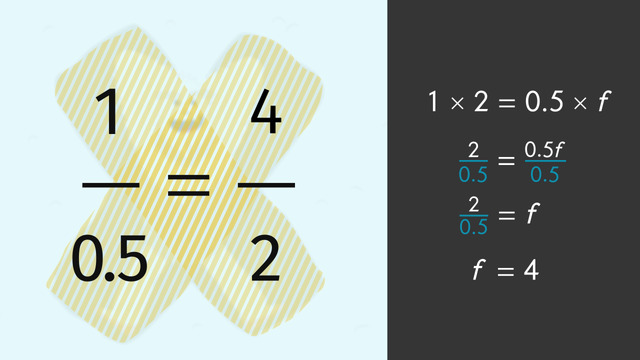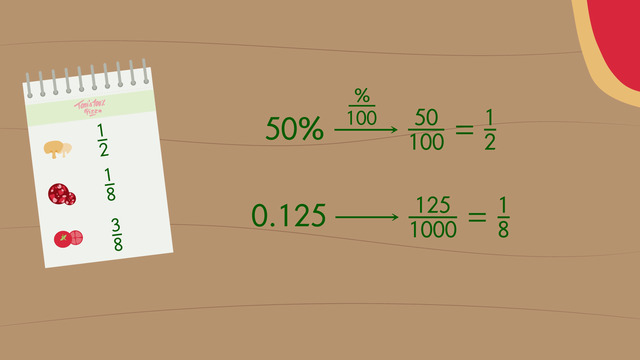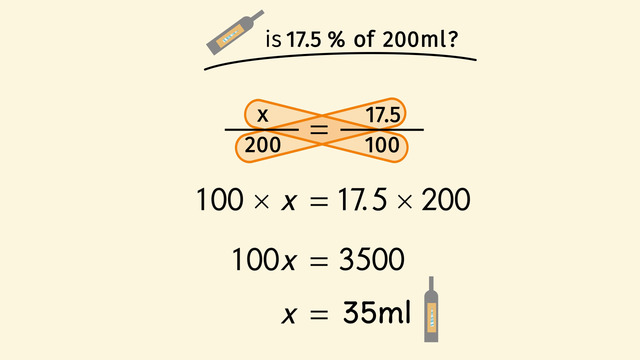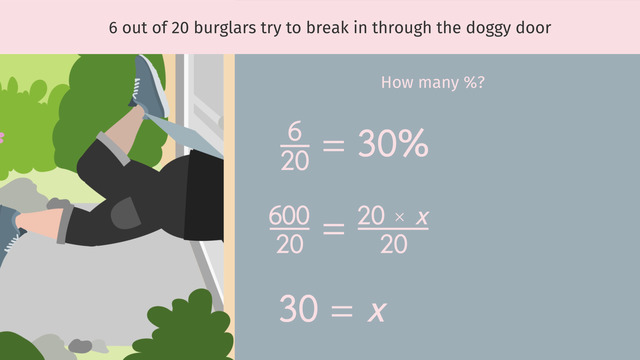Multi-Step Problems with Percent


Basics on the topic Multi-Step Problems with Percent
Imagine you are a runner, training for a marathon, and you need a new pair of running shoes. In the sneaker store, you are bombarded with signs for percent discounts. This gives you a headache because there are so many steps. Isn’t there an easier way to figure out percent discounts? And, what about sales tax… It’s all so complicated.
Solving multi-step problems with percent doesn’t have to be so complicated - if you apply a very smart shortcut. Rather than figuring out the amount of the discount and then subtracting it to determine the discounted price, and then figuring out the sales tax and adding it to the price tax to determine the final price, you can use a shortcut and save a few steps.
What’s the shortcut? Consider the full price of a pair of running shoes as 100% of the price, deduct a discount of 30%, and what do you have left? 70%, now you can calculate 70% of the original price to determine the new discounted price. To figure out the tax, well let’s not spoil the surprise. To learn more about shortcuts to help you quickly solve multi-step problems with discounts and taxes, take a look at this video. About training you to run faster so you can win the marathon, sorry, can’t help you with that.
Analyze proportional relationships and use them to solve real-world and mathematical problems. CCSS.MATH.CONTENT.7.RP.A.1
Transcript Multi-Step Problems with Percent
There is a big ski event today at the South Pole. To show off her mad skiing skills, a pretty Yeti named Betty, wants to rent some new penguin skis, but Betty has a budget, and she doesn’t want to spend more than one hundred fifty fish dollars on the rental. Does she have enough money to rent the skis? Let's find out.
Solving multi-step Problems with Percents
The regular price to rent penguin skis is 225 fish dollars, but for today only, there is a 45% discount. Sales tax is 8% of the original rental price. Let's calculate the total cost of the rental, including the 45% discount and the 8% sales tax.
- First, let's determine the new price of the rental by calculating the discount: 225 · 45% = 101.25. Remember: Percent means you have to divide by 100.
- Next, subtract the discount from the full price: 225 − 101.25 i= 123.75.
- Since we gotta pay the tax man, calculate the 8% tax: 123.75 · 8% = 9.90.
- Taxes increase the price of things, so add the tax to determine the total cost: 123.75 + 9.90 = 133.65.
Betty must pay 133.65, in fish currency, to rent the skis.
Easier way to solve the multi-step Problem with Percents
That's a lot of calculations. You may be thinking… is there an easier way? You betcha! How 'bout I show you a shortcut?
The full price is 225, which is 100%. So, since 100% minus the 45% discount is equal to 55%, we can save a step by calculating 55% of the full price to determine the new price: 225 · 55% = 123.75.
Don't forget to include the sales tax: 100% + 8% = 108%. Multiply the new price times 108%. The total price is 133.65 in fish dollars, of course.
And best of all, Pretty Betty the Yeti has enough money to rent the penguin skis. She is super excited to hit the slopes! But the penguins, they're not so sure.
Multi-Step Problems with Percent exercise
-
Explain the meaning of $45~\%$ discount for the penguin skis.
HintsDiscount is a reduction of the usual price.
For example, a discount of $30~\%$ off the original price of an item that costs $100~\$$, will result in the discounted price of $70~\$$.
Remember: percent means dividing by $100$:
$45~\%=\frac{45}{100}$
SolutionPenguin skis normally cost $225$ fish dollars, but the yeti only has $150$ fish dollars. It's her lucky day, there's a special offer for today: $45~\%$ off the regular price of the rental.
What does this mean for our yeti? First of all, we know that the discounted price is lower than the original price. But how much lower?
To find out, we can calculate $45~\%$ of $225$, and then subtract the outcome from $225$.
An alternate strategy: we can directly calculate $100~\%-45~\%= 55~\%$ of $225$ fish dollars. So, to calculate the new price, we can simply multiply the original price by $55~\%$.
-
Calculate the price the yeti has to pay for the new penguin skis.
HintsBecause the discount will be subtracted, the offer price will be lower than the original price.
Multiplying by $45~\%$ is the same as multiplying by $\frac{45}{100}$.
To multiply an integer with a fraction, first multiply the integer by the numerator then divide the product by the denominator.
SolutionThe full priced rental fee for penguin skis is $225$ fish dollars.
To calculate the price with the discount and tax:
Calculate the discount of $45~\%$ by multiplying the original price by the percentage: $225\times 45~\%=101.25$
Then subtract the discount from the original price: $225-101.25=123.75$
This difference is the reduced price, but we still need to calculate the tax:
Multiply the tax rate by the reduced price: $123.75\times 8~\%=9.90$
Finally, we add the amount of tax to the reduced price: $123.75+9.90=133.65$
Yeah! We know that Betty the yeti has enough money to pay for the skis. She can rent the skis and start skiing!
-
Examine the different rental fees for penguin skis.
HintsKeep in mind that $30~\%$ means $\frac{30}{100}$.
You can use a shortcut to calculate the discounted price and the tax. Take a look at the following example:
The original price is $200$, and there is a special offer of $30~\%$ discount.
$200\times (100~\%-30~\%)=200\times 70~\%=140$
Notice, you can skip a step and still get the same answer.
SolutionFor each shop, let's calculate the rental fee for the penguin skis and the percent discount.
- The lowest price we can get is from the blue shop: $180\times (100~\%-30~\%)=180\times 70~\%=126$.
- The green shop offers skis for $130$ without any discount.
- The red shop offers skis for $230\times (100~\%-40~\%)=230\times 60~\%=138$.
- In the violet shop, you have to pay $160\times (100~\%-10~\%)=160\times 90~\%=144$.
- The yellow shop has an offer of $240\times (100~\%-35~\%)=240\times 65~\%=156$.
-
Calculate the check including the tip.
HintsBefore you can calculate the discount, first add the cost of the burger and the water .
You can either calculate $5\times 10~\%$ and subtract the result from $5$ or calculate $5\times (100~\%-10~\%)=5\times 90~\%$.
The result is the same.
In a similar manner you can either calculate the $20~\%$ tip first and add it to the previous amount or multiply the amount by $120~\%$.
SolutionAfter finishing her delicious meal, Susan wants to pay:
The total price is: $3.75+1.25=5$. Now she can calculate the discount and subtract it:
$5\times 10~\%=0.5$
Susan has to pay $5-0.5=4.5$.
But, Susan wants to give a $20~\%$ tip, so to calculate the tip, she multiplies the new price by $20~\%$:
$4.5\times 20~\%=0.90$
Susan's bill including the tip is $4.5+0.9=5.40$ in total.
-
Change $45~\%$ into a fraction and a decimal.
HintsRemember: percent means parts per hundred.
Notice the result is to shift the decimal point to the left. For example:
$\large{\frac{3}{100}}=0.03$
SolutionFor calculating with percent, it's important that you understand the meaning of percentage.
The actual meaning of percent is per hundred. $45~\%$ can be written as a fraction or as a decimal number. In fraction form, it is easy to recognize the meaning of per hundred:
$45~\%=\frac{45}{100}=0.45$
-
Evaluate the final check the Yetis and the Penguins have to pay.
HintsWithout the discount and the tip, the yetis would pay $64$ dollars.
They get a discount of $12.80$ dollars.
SolutionFirst, let's have a look at the yetis. We calculate their total check by adding the prices for their lemonades and chips:
$15\times 3+5\times 3.8=64$
The discount can be calculated by:
$64\times 20~\%=12.80$
This amount has to be subtracted from the original price:
$64-12.80=51.20$
Now we can calculate the tip:
$51.20\times 15~\%=7.68\approx 7.70$
And add it to the bill:
$51.20+7.70=58.90$.
Therefore the yetis have to pay $\$~58.90$ in total.
$~$
Now we take a look at the penguins. Their total check is:
$12\times 4.5=54$
The discount can be calculated as follows:
$54\times 35~\%=18.90$
Subtracting the discount leads to:
$54-18.90=35.10$
Now we only need to add the tip $35.10\times20~\%=7.02\approx 7.00$
So we get $35.10+7.00=42.10$.
The penguins have to pay $\$~42.10$ in total.

















